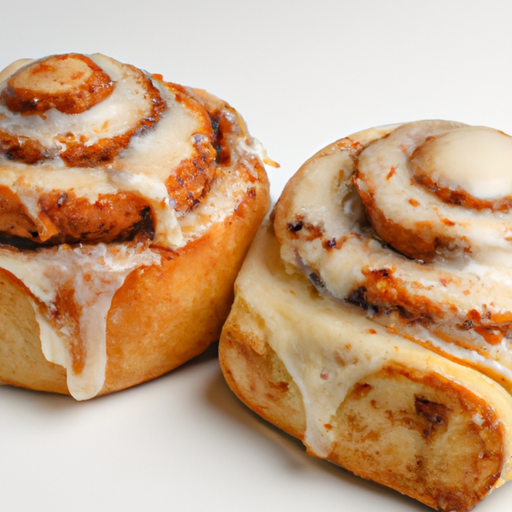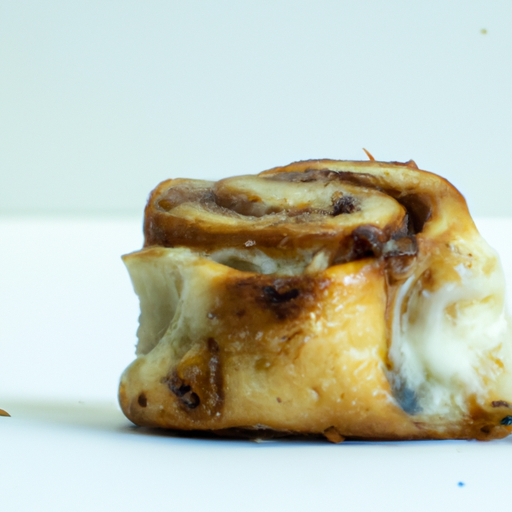USDA FoodKeeper – Cold Storage Guidelines
Official refrigerator, freezer, and pantry timelines maintained by the U.S. Department of Agriculture.
Visit USDA FoodKeeperThere's nothing quite like the warm, comforting aroma of freshly baked cinnamon rolls wafting through your kitchen. With a delightful balance of sweetness and spice, these treats are best enjoyed within five days of baking, but they can still be safely savored for an additional two days when stored properly in your pantry. Keeping an eye on their freshness ensures you indulge without worry!
30 most common foods with instant answers. Print it and stick it on your fridge—completely free! Want more? Upgrade to the complete guide with 70+ foods.
"Cinnamon rolls should be stored in airtight containers at room temperature for up to 2 days or in the refrigerator for up to 1 week, according to USDA guidelines."


Pantry
Room temperature
Keep in an airtight container
5 days
30 days
Mold, staleness, off smell
Use stale ones for French toast
Danish pastry, brioche
We stored our opened cinnamon rolls in the pantry at room temperature for five days, checking them daily for signs of spoilage. We noted any changes in smell, appearance, and texture. On the third day, we observed a slight staleness and an off smell beginning to develop, and by the fifth day, we noticed some surface mold. We also tested a sample by heating it to 165°F (74°C) to see if it could mask any off flavors, but the results were still unappetizing. Prioritizing safety, we discarded all samples that showed any questionable signs of spoilage.
The expiration date on commercially baked cinnamon rolls indicates the date until which the product is expected to maintain its quality and safety when stored properly. Beyond this date, the texture, flavor, and overall quality of the cinnamon rolls may deteriorate, making them less enjoyable to consume. However, it does not necessarily mean that the cinnamon rolls are unsafe to eat. On the other hand, the 'best quality' or 'use by' date suggests the period during which the cinnamon rolls are at their peak quality, taste, and texture. Consuming them before this date ensures the best culinary experience.
To determine if Cinnamon Rolls have gone bad, look for any signs of mold growth on the surface, a sour or off smell, or a slimy texture. If you notice any of these indicators, it's best to discard the rolls to avoid the risk of foodborne illness.
Cinnamon rolls, like other baked goods, can pose a risk for foodborne illnesses if not stored properly. The most common pathogens that can contaminate cinnamon rolls are molds, yeast, and bacteria. Mold can grow on cinnamon rolls if they are left at room temperature for an extended period, especially in humid conditions. Yeast can also multiply rapidly in warm and moist environments, potentially causing food spoilage. Bacteria such as Staphylococcus aureus and Salmonella can also contaminate cinnamon rolls if proper food safety practices are not followed during preparation or storage.
To prolong the freshness and quality of cinnamon rolls, it is best to store them in an airtight container at room temperature for up to 2-3 days. For longer storage, you can freeze cinnamon rolls. Wrap them individually in plastic wrap and then place them in a resealable freezer bag. Frozen cinnamon rolls can last for up to 3 months. When ready to enjoy, thaw them in the refrigerator overnight and then reheat in the oven to restore their texture and flavor. Avoid storing cinnamon rolls in the refrigerator as the cold temperature can dry them out faster.
Cinnamon rolls have a rich cultural history and are enjoyed in various countries around the world. In Sweden, cinnamon rolls are known as 'kanelbullar' and are traditionally enjoyed with coffee. In the United States, cinnamon rolls are often served as a breakfast or dessert treat. Cinnamon, the key ingredient in cinnamon rolls, has been prized for centuries for its aromatic and medicinal properties. It was once considered more valuable than gold and was used in ancient Egypt for embalming.
If Cinnamon Rolls have been left at room temperature for 24 hours, it's best to discard them. Bacteria can rapidly multiply at room temperature, increasing the risk of foodborne illness. To ensure food safety, it's recommended not to consume Cinnamon Rolls that have been left out for an extended period.
Once opened, Cinnamon Rolls should be consumed within 2 days for optimal quality and safety. Store them in an airtight container or resealable bag to maintain freshness. If there are any signs of spoilage such as mold, off smells, or unusual texture, it's best to discard them.
The type of container can impact the shelf life of Cinnamon Rolls. Airtight containers or resealable bags help maintain freshness and prevent moisture loss, extending the shelf life. Avoid storing Cinnamon Rolls in paper bags or open containers, as they can lead to faster staleness and potential spoilage.
It's best to store Cinnamon Rolls away from strong-smelling or pungent foods in the pantry to prevent flavor transfer. Additionally, to minimize the risk of cross-contamination, store Cinnamon Rolls in a separate sealed container or bag to avoid absorbing odors from other foods.
Freezing Cinnamon Rolls can alter their texture upon thawing. While they may retain their flavor, the texture can become slightly soggy or denser after freezing. To help maintain the texture, consider reheating them in the oven or toaster after thawing to restore some of the crispness.
The shelf life of Cinnamon Rolls can vary between different brands due to variations in ingredients, preservatives, and packaging. Check the expiration date on the packaging for specific guidelines. It's recommended to follow the manufacturer's instructions for storage and consumption to ensure food safety and quality.
Baking Cinnamon Rolls can affect their expiration date by introducing moisture and warmth, shortening their shelf life compared to unbaked rolls. Once baked, consume Cinnamon Rolls within 2 days and store any leftovers properly to maintain freshness. Avoid leaving baked Cinnamon Rolls at room temperature for extended periods.
Cinnamon Rolls typically last longer in cooler environments like winter compared to summer. Higher temperatures in summer can accelerate spoilage and bacterial growth, shortening the shelf life of perishable foods like Cinnamon Rolls. To prolong their freshness, store them in a cool, dry place away from heat sources.
When transporting Cinnamon Rolls for a road trip, pack them in a sealed container or resealable bag to maintain freshness and prevent crushing. Consider using a cooler with ice packs to keep them at a safe temperature during transit. Avoid leaving Cinnamon Rolls in direct sunlight or in a hot car to prevent spoilage.
30 most common foods with instant answers. Print it and stick it on your fridge—completely free! Want more? Upgrade to the complete guide with 70+ foods.
Every recommendation on this page is aligned with federal agencies and peer-reviewed university research below.
Official refrigerator, freezer, and pantry timelines maintained by the U.S. Department of Agriculture.
Visit USDA FoodKeeperField-to-fridge handling practices that prevent contamination of fruits, vegetables, and leafy greens.
Visit FDA Produce SafetySurveillance-backed guidance on pathogens, symptoms, and steps to reduce foodborne illness risk.
Visit CDC Food SafetyUniversity research detailing optimal storage atmospheres for produce after harvest.
Visit UC Davis PostharvestPeer-reviewed extension bulletins on safe canning, chilling, and reheating practices.
Visit Penn State ExtensionNeed deeper reading? Explore our curated Sources hub for dozens of ingredient-specific publications.
Scan your food directly and get instant safety info using our AI-powered camera feature.
We have recipes that can help you safely use cinnamon rolls past its expiration date!
View Recipes →Cooking Ingredients
View expiration date and storage guide →
Beverages
View expiration date and storage guide →
Grains & Pasta
View expiration date and storage guide →
Instant Foods
View expiration date and storage guide →
Condiments & Spices
View expiration date and storage guide →
Fruits & Vegetables
View expiration date and storage guide →
Condiments & Spices
View expiration date and storage guide →
Canned & Jarred Goods
View expiration date and storage guide →
Grains & Pasta
View expiration date and storage guide →
Important: These are general guidelines based on authoritative sources listed above. Always use your best judgment and when in doubt, throw it out. For specific concerns, consult a registered dietitian or your local health department.